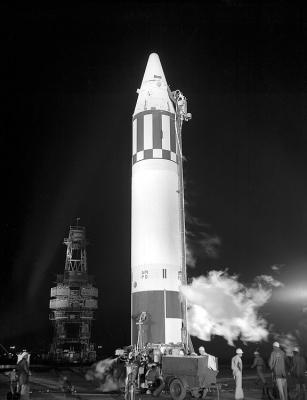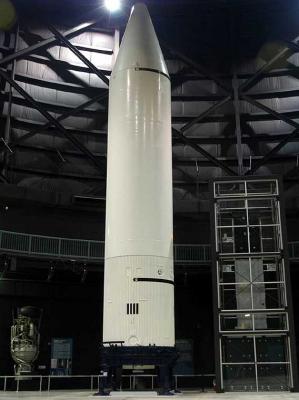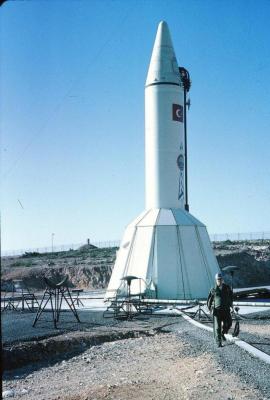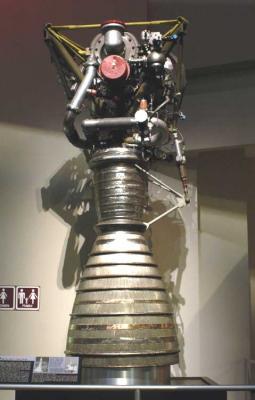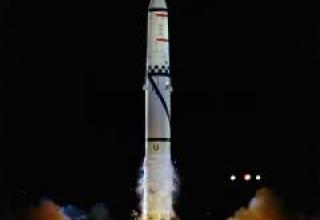The Jupiter medium-range ballistic missile (MRBM) is a direct descendant of the Redstone missile, which was created under the leadership of W. Von Braun in the Ordnance Guided Missile Center. The "Redstone" had a maximum range of about 240 km. While work on the Redstone was still in progress, the U.S. Army Artillery Administration began to develop requirements for a promising missile with a range of at least 1600 km. Already in 1953, encouraged by the successful implementation of the Redstone program, W. von Braun came to the conclusion that the development of a long-range missile is possible, and asked the Chief of Artillery for permission to begin developing a new attack vehicle. However, the Army leadership initially showed little interest in the von Brown proposal, and the development of the new missile was ranked as a low-priority research programme.
Everything changed in 1955 after the so-called Killian committee appealed to President D. Eisenhower. The committee's report stated that, in addition to the development of ICBMs, the U.S. should immediately begin developing MRBMs with a range of about 2400 km. A new class of missiles was to be deployed both on land (on U.S. bases in Europe) and at sea (options were considered for basing new missiles on submarines as well as on special ships). The need to develop a new class of missiles was proved by references to intelligence that indicated that the USSR had already begun to develop its own MRBMs. By the end of 1955, the Army, Air Force and Navy declared their fundamental readiness to start developing MRBMs. However, the beginning of concrete actions was hindered by uncertainty about which agency would be responsible for the development of new missiles. In November 1955, Minister of Defense Ch. Wilson announced that the Air Force would be responsible for the development of land-based MRBMs, and the joint Army / Navy team would be responsible for the development of sea-based MRBMs. In December 1955, President D. Eisenhower named the MRBM development program a top priority. Given the Army's considerable experience in missile development, Navy leadership agreed that the development and production of prototypes would be carried out at the Redstone Army Arsenal. In February 1956, the Army Ballistic Missile Agency was established in Redstone Arsenal to manage the new program.
However, despite the promising start, the development programme of the new MRDC soon faced difficulties. In September 1956, the U.S. Navy refused to participate in the MRBM development program, preferring the Polaris program. In November of the same year, Defense Minister Wilson decided that all missiles with a range of more than 320 km will be created and operated only by the Air Force. This dramatically reduced the Army's interest in the program to develop its own MRBMs. Ultimately, however, the decision was made to continue building an "army" MRBM in the Redstone Arsenal called the Jupiter and designated SM-78. This decision was explained by the numerous difficulties encountered by the Air Force in developing the MRBM - "Thor".
In September 1955, the MRBM prototype named "Jupiter A" was launched for testing. from the launch pads of the Atlantic Missile Range. In testing the Jupiter A rocket, the emphasis was on testing the basic design, control system and engines. A little later, the Jupiter C rocket was tested. that was used to test the head end and the separation system. From September 1955 to June 1958 was launched 28 missiles "Jupiter A" and "Jupiter C". The "Jupiter" missile in a configuration close to the standard, went to testing in 1956. In May 1956. MRBM "Jupiter", launched from the Atlantic Rocket Test Site, flew about 1850 km. By July 1958, 10 Jupiter MRBMs were launched.
The success of the "Jupiter" program, coupled with the failures of the program "Thor", gave the army leadership hope that the production and deployment will be selected for "their" rocket. However, on the wave of fear caused by the successful launch of the Soviet Union's First Sputnik on October 4, 1957, President Eisenhower ordered the full-scale production of both MRBMs. To the Army's dissatisfaction with the Minister of Defense's earlier decision, the Air Force began to gradually subordinate the entire Jupiter program to itself - already in February 1958, the Air Force established its permanent office in the Redstone Arsenal, and in March of the same year, the Air Force established a special liaison department whose main task was to coordinate all activities between the Army and the relevant Air Force commands. In January 1958, the Air Force activated 864th Strategic Missile Squadron in Huntsville to prepare calculations of MRBM "Jupiter". In June of the same year, 865th and 866th strategic missile squadrons were activated in Huntsville.
While the Air Force was training personnel for the new MRBM, the U.S. State Department was actively negotiating with a number of European countries to deploy Jupiter missiles on their territory. Initially it was planned to place 45 missiles on the territory of France, but the negotiations were not successful. In the end, Italy and Turkey agreed to host the missiles. The first agreed by Italy - in March 1958, the government of the country has given its consent in principle for the deployment of two missile squadrons (15 MRBM in each) on Italian territory, the final decision was taken in September the same year, and the main agreement was signed in March 1959. However, in return, the Italians wanted to exercise control over the missiles independently, within the organizational structure of their national air force. The Americans did not object (especially since under the current rules the control of thermonuclear missiles was still to be carried out by American personnel, MRBMs also remained American property). In May 1959, the first Italian servicemen selected for service on MRBM "Jupiter", arrived at Lackland Air Base (Texas), for training. In August of the same year, the resolution of all outstanding issues was reflected in a specially signed bilateral agreement. Training of Italian personnel in the U.S. was completed in October 1960, after which the Italians gradually replaced most of the U.S. personnel at the launch sites already partially deployed in Italy missiles. At the end of October 1959, the Turkish government also expressed its consent (on the same terms as Italy) to the deployment of a missile squadron (15 MRBM) on its territory. As in the case of Italy, the resolution of all outstanding issues was reflected in a bilateral agreement signed in May 1960.
The first serial MRBM "Jupiter" came off the assembly line in August 1958. The following contractors were selected to produce Jupiter missiles:
- Ballistic Missile Division of Chrysler Corporation - production of hull units and final assembly of the missile as a whole;
- North American Aviation's Rocketdyne Division - propulsion system production;
- Ford Instrument, manufacture of the control system;
- General Electric Corporation - production of a combat unit.
In 1962, when the designation system in the Air Force changed, the missile received a new designation PGM-19A.
While the issues of production and basing of the new missile were solved (in November 1959, an agreement was signed between the Air Force and the Army, under which from 1959 the Air Force became fully responsible for the implementation of the program "Jupiter"), the personnel of the Strategic Air Command were trained using the missile "Redstone". Later, as part of the ISWT (Integrated Weapons System Training) program in the Redstone Arsenal, training began directly using Jupiter missiles and equipment. The last test launch of Jupiter MRBMs took place in February 1960. The first launch of Jupiter MRBM with simulated combat situation by trained personnel of the SAC Air Force from the Atlantic Rocket Test Site was carried out in October 1960. By this time, for several months (from July 1960) the missiles began to go on duty in Italy, based on the Italian Air Force Joya delle Collie. Fully operational readiness of all 30 "Italian" MRBMs was achieved in June 1961. The base on the territory of Italy received the code designation NATO I. Full operational readiness of 15 "Turkish" missiles was achieved in April 1962 (the first missiles were on duty in November 1961). Missiles were placed on the base of Turkish Air Force Tigli, the base was code-named NATO II. As in the case of Italy, at first the missiles were served only by American personnel, Turkish personnel replaced most of the American by May 1962. The first training and combat launch of the MRBM by Italian personnel was carried out in April 1961.
The first training and combat launch of BRSD by Turkish personnel was carried out in April 1962.
In December 1960, the last serial BRSD "Jupiter" came off the assembly lines.
Naturally, 45 deployed Jupiter MRBMs (to which should be added 60 more Thor MRBMs deployed in the UK), combined with the clear superiority of the U.S. in the number of deployed ICBMs and strategic bombers, could not but cause acute concern to the military and political leadership of the USSR. Given the situation, it was decided in response to deploy Soviet MRBMs R-12 and R-14 on the island of Cuba as part of "Operation Anadyr," which resulted in the well-known crisis in October 1962. As part of the agreement concluded by the leadership of the USSR and the United States, Soviet missiles were withdrawn from Cuba in exchange for the deactivation of missiles "Jupiter" in Italy and Turkey (the decision to deactivate missiles "Thor" in Britain was taken before the crisis, in August 1962). The decision to deactivate the "Italian" and "Turkish" missiles was announced in January 1963, in the same month the last, sixth, training and combat launch of MRBM "Jupiter" by Italian personnel. In February 1963, the Air Force began preparations for the de-alerting of MRBMs as part of operations Pot Pie I ("Italian" missiles) and Pot Pie II ("Turkish" missiles). All missiles were removed from Italy by the end of April 1963 and from Turkey by the end of July of the same year.
Composition:
The Jupiter MRBM (see diagram) consisted of two parts, which were assembled in the field:
- unit compartment with LPD and fuel component tanks;
- instrument/engine compartment with fixed HF.
The BRSD power unit was developed at Redstone Arsenal. The main engine is S3D. Fuel components: fuel - rocket kerosene RP-1, oxidizer - liquid oxygen. Main engine nozzle - controlled, deflected in the suspension unit to control the missile through the channels of pitch and yaw. Aerodynamic rudders and stabilizers were absent. The combustion chamber of the engine was separated from other components of the remote control by a special heat-resistant wall. The lining of the tail part of the rocket, where the remote control was located, had a corrugated lining to improve its strength characteristics. The fuel component tank compartment was placed on top of the remote control compartment and was separated from the last one by a special bulkhead. In turn, the oxidizer (bottom) and fuel tanks (top) were also separated by a special bulkhead. A special bulkhead separates the fuel tank from the instrument compartment. The "Jupiter" rocket had a supporting structure of the tanks. The casing was welded from aluminum panels. The fuel supply piping went through the oxidizer tank, and the control cables went through there. The fuel components were fed into the combustion chamber by pumps driven by a turbine powered by the main fuel components. The exhaust gas was used to control the rocket through a roll channel. Before the launch, the tanks were inflated with nitrogen from a special tank (see layout diagram).
The head unit, which had the army designation Mk3, was equipped with ablative (enveloping) thermal protection made of organic materials and contained a thermonuclear BC W-49 with a capacity of 1.44 Mt, which allowed to confidently hit the area targets. The head end was connected to the instrument/engine compartment, where the inertial control system and the unit of solid propellant motors for orientation and stabilization were located. The main (vernier) solid propellant engine was triggered 2 seconds after separation of the assembly of the HF/ instrumentation compartment from the assembly compartment (they were connected by 6 pyrobolts) and adjusted the assembly speed to an accuracy of ±0.3 m/s. After the assembly had passed the apogee of the trajectory, two low-power solid propellant engines were actuated, twisting the assembly for stabilization. The instrument/engine compartment was then separated from the GC using a detonation cord and then burned in dense atmospheric layers (see trajectory diagram).
The rocket "Jupiter" was created as a mobile MRBM, which was transported by road. Squadron of MRBM "Jupiter" consisted of 15 missiles (5 links on 3 MRBM) and about 500 officers and soldiers. Each link was placed several kilometres apart in order to reduce vulnerability to nuclear attack. For the same purpose, the missiles of the same link were placed several hundred meters apart. Each link was served by five officers and ten soldiers in the position itself (see diagram of the starting position).
The equipment and rockets of each unit were deployed in about 20 vehicles:
- two power supply machines;
- one power distribution machine;
- two theodolite machines;
- hydraulics and pneumatics machine;
- oxidizer refueling machine;
- fuel tanker machine;
- three oxidizer tankers;
- complex control machine;
- liquid nitrogen tanker machine;
- BRSD and HC transportation vehicles;
- auxiliary machines.
The missile was placed on a special launch table to which it was docked, after which the entire structure was brought to an upright position, and the lower third of the missile was closed by a special light metal shelter, allowing to serve the missile in bad weather. The rocket was refueled with fuel components in 15 minutes. The rocket was launched on command from a special vehicle by a crew of an officer and two soldiers. Each squadron carried out maintenance of the material part at a special base, which had at its disposal all the necessary materials, as well as a plant for the production of liquid oxygen and liquid nitrogen.
Characteristics:
| Range of fire, km | 2400 |
| KVO, km | 1.5 |
| BC power, Mt. | 1.44 |
| Length, m | 18.3 |
| Diameter, m | 2.69 |
| Start mass, t | 49.35 |
| Main engine running time, s | 158 |
| Engine traction at sea level, t | 67.5 |
| Vernier engine running time, s | 12 |
Testing:
One of the first carriers of the complex is a multipurpose nuclear submarine of the project 885 "Ash", which belongs to the fourth generation of submarines. The keelmark in the series, called "Severodvinsk", took place on December 21, 1993. The boat carries 24 missiles in inclined launch shafts. The natural model of the new anti-ship missile in an export version (a variant for underwater, surface and shore-based), was first publicly demonstrated at the exhibition MAKS-97. It was also exhibited at MAKS-99.
The advertising passport for the small rocket ship of project 21632 "Tornado" (approved on 26.04.2008) indicates the possibility of placing the Yakhont complex as one of the weapon variants.
According to military analysts' forecasts, the Yakhont complex will have no analogues in the world for another 10 years. This can be proved by the interest expressed by foreign buyers. A number of countries of the Asia-Pacific region, the Middle East, which in the past bought Russian ships and boats with cruise missiles, have already become interested in the novelty of the domestic military industrial complex. PCR Yakhont also has good prospects in terms of upgrading foreign-built ships, where it can replace the Harpoon, Exocet, and Otomat anti-ship complexes.
Sources:
- To defend and deter: the legacy of the United States cold war missile program / by J.C. Lonnquest and D.F. Winkler. USACERL, Champaign, IL, 1997.
- From Snark To Peacekeeper: A Pictorial History of SAC Missiles / by Office of the Historian HQ SAC. OH HQ SAC, Offut AFB, NE, 1990.
- SAC Missile Chronology 1939-1988 / by Office of the Historian HQ SAC. OH HQ SAC, Offut AFB, NE, 1990.
- Alert Operations and the SAC 1957-1991 / by Office of the Historian HQ SAC. OH HQ SAC, Offut AFB, NE, 1990.
- SAC and the Alert Program: A Brief History / by Office of the Historian HQ SAC. OH HQ SAC, Offut AFB, NE, 1988.
- The Development of Ballistic Missiles in the United States Air Force / J. Neufeld. Office of AF history, USAF, DC, 1990
- US Strategic and Defensive missile systems 1950-2004 / M.A. Berhow and C. Taylor. Osprey Publishing Ltd., 2005.
- Широкорад А.Б. «Атомный таран XX века», 2005 Москва, «Вече».
- А.А. Шумилин «Авиационно-космические системы США», 2005 Москва, «Вече».
- www.nationalmuseum.af.mil
